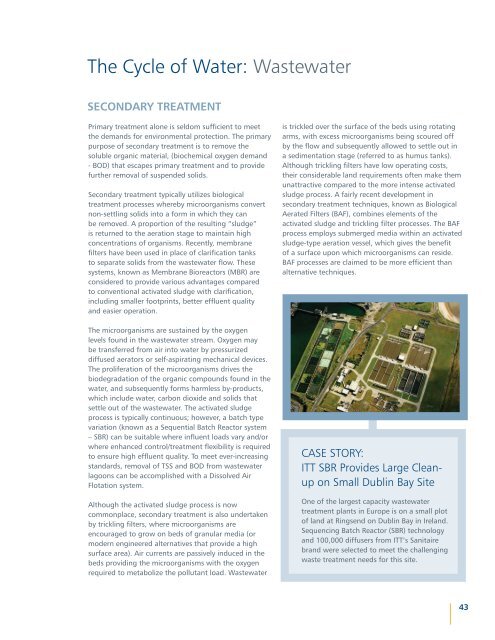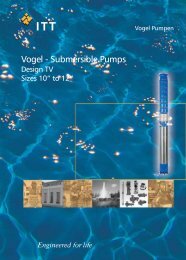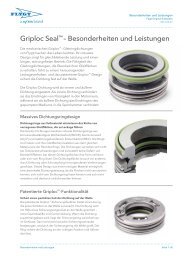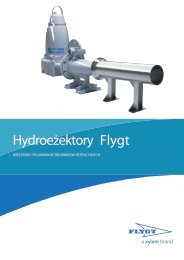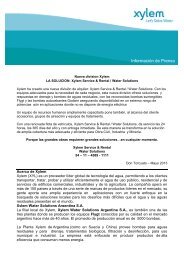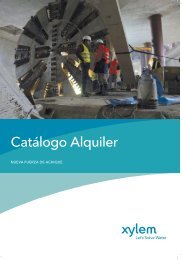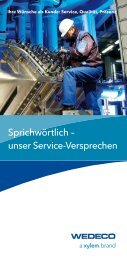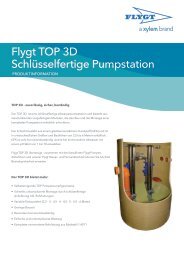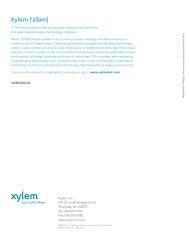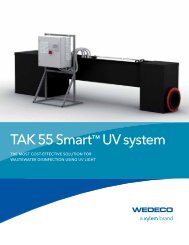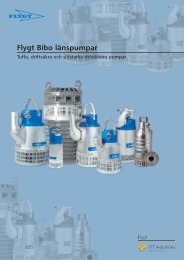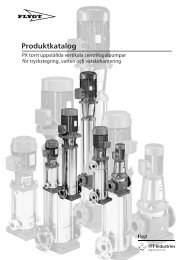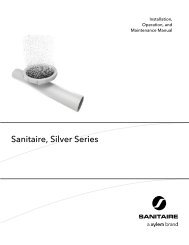ITT's Place in the Cycle of Water - Water Solutions
ITT's Place in the Cycle of Water - Water Solutions
ITT's Place in the Cycle of Water - Water Solutions
Create successful ePaper yourself
Turn your PDF publications into a flip-book with our unique Google optimized e-Paper software.
The <strong>Cycle</strong> <strong>of</strong> <strong>Water</strong>: Wastewatersecondary treatmentPrimary treatment alone is seldom sufficient to meet<strong>the</strong> demands for environmental protection. The primarypurpose <strong>of</strong> secondary treatment is to remove <strong>the</strong>soluble organic material, (biochemical oxygen demand- BOD) that escapes primary treatment and to providefur<strong>the</strong>r removal <strong>of</strong> suspended solids.Secondary treatment typically utilizes biologicaltreatment processes whereby microorganisms convertnon-settl<strong>in</strong>g solids <strong>in</strong>to a form <strong>in</strong> which <strong>the</strong>y canbe removed. A proportion <strong>of</strong> <strong>the</strong> result<strong>in</strong>g “sludge”is returned to <strong>the</strong> aeration stage to ma<strong>in</strong>ta<strong>in</strong> highconcentrations <strong>of</strong> organisms. Recently, membranefilters have been used <strong>in</strong> place <strong>of</strong> clarification tanksto separate solids from <strong>the</strong> wastewater flow. Thesesystems, known as Membrane Bioreactors (MBR) areconsidered to provide various advantages comparedto conventional activated sludge with clarification,<strong>in</strong>clud<strong>in</strong>g smaller footpr<strong>in</strong>ts, better effluent qualityand easier operation.The microorganisms are susta<strong>in</strong>ed by <strong>the</strong> oxygenlevels found <strong>in</strong> <strong>the</strong> wastewater stream. Oxygen maybe transferred from air <strong>in</strong>to water by pressurizeddiffused aerators or self-aspirat<strong>in</strong>g mechanical devices.The proliferation <strong>of</strong> <strong>the</strong> microorganisms drives <strong>the</strong>biodegradation <strong>of</strong> <strong>the</strong> organic compounds found <strong>in</strong> <strong>the</strong>water, and subsequently forms harmless by-products,which <strong>in</strong>clude water, carbon dioxide and solids thatsettle out <strong>of</strong> <strong>the</strong> wastewater. The activated sludgeprocess is typically cont<strong>in</strong>uous; however, a batch typevariation (known as a Sequential Batch Reactor system– SBR) can be suitable where <strong>in</strong>fluent loads vary and/orwhere enhanced control/treatment flexibility is requiredto ensure high effluent quality. To meet ever-<strong>in</strong>creas<strong>in</strong>gstandards, removal <strong>of</strong> TSS and BOD from wastewaterlagoons can be accomplished with a Dissolved AirFlotation system.Although <strong>the</strong> activated sludge process is nowcommonplace, secondary treatment is also undertakenby trickl<strong>in</strong>g filters, where microorganisms areencouraged to grow on beds <strong>of</strong> granular media (ormodern eng<strong>in</strong>eered alternatives that provide a highsurface area). Air currents are passively <strong>in</strong>duced <strong>in</strong> <strong>the</strong>beds provid<strong>in</strong>g <strong>the</strong> microorganisms with <strong>the</strong> oxygenrequired to metabolize <strong>the</strong> pollutant load. Wastewateris trickled over <strong>the</strong> surface <strong>of</strong> <strong>the</strong> beds us<strong>in</strong>g rotat<strong>in</strong>garms, with excess microorganisms be<strong>in</strong>g scoured <strong>of</strong>fby <strong>the</strong> flow and subsequently allowed to settle out <strong>in</strong>a sedimentation stage (referred to as humus tanks).Although trickl<strong>in</strong>g filters have low operat<strong>in</strong>g costs,<strong>the</strong>ir considerable land requirements <strong>of</strong>ten make <strong>the</strong>munattractive compared to <strong>the</strong> more <strong>in</strong>tense activatedsludge process. A fairly recent development <strong>in</strong>secondary treatment techniques, known as BiologicalAerated Filters (BAF), comb<strong>in</strong>es elements <strong>of</strong> <strong>the</strong>activated sludge and trickl<strong>in</strong>g filter processes. The BAFprocess employs submerged media with<strong>in</strong> an activatedsludge-type aeration vessel, which gives <strong>the</strong> benefit<strong>of</strong> a surface upon which microorganisms can reside.BAF processes are claimed to be more efficient thanalternative techniques.CASE STORY:ITT SBR Provides Large Cleanupon Small Dubl<strong>in</strong> Bay SiteOne <strong>of</strong> <strong>the</strong> largest capacity wastewatertreatment plants <strong>in</strong> Europe is on a small plot<strong>of</strong> land at R<strong>in</strong>gsend on Dubl<strong>in</strong> Bay <strong>in</strong> Ireland.Sequenc<strong>in</strong>g Batch Reactor (SBR) technologyand 100,000 diffusers from ITT’s Sanitairebrand were selected to meet <strong>the</strong> challeng<strong>in</strong>gwaste treatment needs for this site.43


